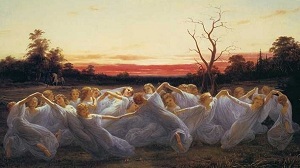EVERYTHING
FAIRIES
- Facts
- Legends
- Stories
- Resources

Fairy stories:
Fairies appeared in medieval romances as one of the beings that a knight errant might encounter. A fairy lady appeared to Sir Launfal and demanded his love; like the fairy bride of ordinary folklore, she imposed a prohibition on him that in time he violated. Sir Orfeo's wife was carried off by the King of Faerie. Huon of Bordeaux is aided by King Oberon. These fairy characters dwindled in number as the medieval era progressed; the figures became wizards and enchantresses. Morgan le Fay, whose connection to the realm of Faerie is implied in her name, in Le Morte d'Arthur is a woman whose magic powers stem from study.
While somewhat diminished with time, fairies never completely vanished from the tradition. Sir Gawain and the Green Knight is a late tale, but the Green Knight himself is an otherworldly being. Edmund Spenser featured fairies in The Faerie Queene. In many works of fiction, fairies are freely mixed with the nymphs and satyrs of classical tradition; while in others (e.g. Lamia), they were seen as displacing the Classical beings. 15th century poet and monk John Lydgate wrote that King Arthur was crowned in "the land of the fairy", and taken in his death by four fairy queens, to Avalon where he lies under a "fairy hill", until he is needed again.

Fairies appear as significant characters in William Shakespeare's A Midsummer's Night Dream, which is set simultaneously in the woodland, and in the realm of Fairyland, under the light of the moon. and in which a disturbance of Nature caused by a fairy dispute creates tension underlying the plot and informing the actions of the characters. According to Maurice Hunt, Chair of the English Department at Baylor University, the blurring of the identities of fantasy and reality makes possible “that pleasing, narcotic dreaminess associated with the fairies of the play”.
Shakespeare's contemporary, Michael Drayton features fairies in his Nimphidia; from these stem Alexander Pope's sylphs of The Rape of the Lock, and in the mid 17th century, précieuses took up the oral tradition of such tales to write fairy tales; Madame d'Aulnoy invented the term contes de fée ("fairy tale"). While the tales told by the précieuses included many fairies, they were less common in other countries' tales; indeed, the Brothers Grimm included fairies in their first edition, but decided this was not authentically German and altered the language in later editions, changing each "Fee" (fairy) to an enchantress or wise woman. J. R. R. Tolkien described these tales as taking place in the land of Faerie. Additionally, not all folktales that feature fairies are generally categorized as fairy tales.
Fairies in literature took on new life with Romanticism. Writers such as Sir Walter Scott and James Hogg were inspired by folklore which featured fairies, such as the Border ballads. This era saw an increase in the popularity of collecting of fairy folklore, and an increase in the creation of original works with fairy characters. In Rudyard Kipling's Puck of Pook's Hill, Puck holds to scorn the moralizing fairies of other Victorian works. The period also saw a revival of older themes in fantasy literature, such as C.S. Lewis's Narnia books which, while featuring many such classical beings as fauns and dryads, mingles them freely with hags, giants, and other creatures of the folkloric fairy tradition.[84] Victorian flower fairies were popularized in part by Queen Mary’s keen interest in fairy art, and by British illustrator and poet Cicely Mary Barker's series of eight books published in 1923 through 1948. Imagery of fairies in literature became prettier and smaller as time progressed. Andrew Lang, complaining of "the fairies of polyanthuses and gardenias and apple blossoms" in the introduction to The Lilac Fairy Book, observed that "These fairies try to be funny, and fail; or they try to preach, and succeed."
Fairies are seen in Neverland, in Peter and Wendy, the novel version of J. M. Barrie's famous Peter Pan stories, published in 1911, and its character Tinker Bell has become a pop culture icon. When Peter Pan is guarding Wendy from pirates, the story says: "After a time he fell asleep, and some unsteady fairies had to climb over him on their way home from an orgy. Any of the other boys obstructing the fairy path at night they would have mischiefed, but they just tweaked Peter's nose and passed on."


|
Most pet owners would NEVER knowingly poison their animal, but many do! They feed their pets nutritional supplements that contain artificial chemicals in amounts toxic to many types of animals and even children. We recommend NU-VET products. These natural supplements help meet the nutritional needs of your pet, without exposing them to the risk of artificial chemicals. Call 1-800-474-7044, Discount Code 42050, to order by phone. Order NuVet online. Click on the e-store link. Save BIG on supplements, toys, flea collars &more! |
The Make Life Work For You Family of Helpful Websites
Politics and Entertainment Commentaries
Appalling Behavior - Celebrities Behaving Badly
APA - Dog and Puppy Registrations
ACA - Chihuahua Dog and Puppy Registrations
St Patrick's Day Around The World
Good, bad and Funny Excuses For Being Late
